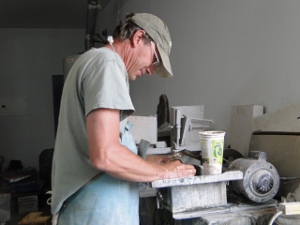Cutting Cabochons


Making jewelry using semi precious stone cabochons:
There are four standard ways of making jewelry. There is lost wax casting-where the design is done in wax and then cast in metal, there is metalsmithing-where the work is done with metal, there is wirewrapping, and then there is snap settings-premade settings, usually cast, that all you have to do is add a standard cut gemstone to.
For obvious reasons custom cut cabochons are not usually used in the latter type. For the other 3 types, the jeweler may have a design in mind and then go looking for a stone cabochon, or find a designer cabochon that “speaks” to them and design around it. Jewelers can go through 1000’s of cabochon stones looking for just the right one. And it can be very frustrating when the one they find is out of their budget.
Why are custom cut gemstone cabochons so much more expensive than standard commercial ones?
The main problem of course is the product we sell. We sell a product that takes millions of years to produce, is sometimes found only in one area, and many times the deposits get played out. The natural gemstone materials can even change in pattern or color from one foot to the next of the deposit! Often you don’t really know what you’re getting when you buy the rough rock, until you actually start cutting it. It is not like you can just pick up the phone and order 1000 more hamburgers. And there is no cost control. Miners from Mexico come up to the Tucson Gem Show, see the prices and suddenly want more for their rough. Or a newbie pays a ridiculous price for a rock and suddenly the seller thinks its worth a fortune. Some countries ban the export of rough. And China buys a lot of rough before it ever hits the market! They buy so much that they usually get a much cheaper price than anybody else. Lapidary rough rock is difficult to buy sight unseen, but traveling to check it out or find new sources is expensive and, especially lately, shipping cost can be exorbitant. Most of the time when you buy rough you don’t buy one or two pieces, you buy 100’s or even 1000’s of pounds. And we won’t even go into the difficulties and expensive of mining it yourself -that’s for another article! You can usually get a better price if you buy "mine run" material, but then you get the good with the bad. Generally only 5-8% of mine run material is high grade. You can sometimes buy material already high graded, or pick it yourself, but that usually cost quite a bit more.
Next begins cabochon cutting or "cabbing". First you have to slab the rough rock, losing more material in the cut. From the slab a good custom cutter tries to orientate the cabochon for best color, pattern, or orientation, and to try to cut around any fracture lines or flaws in the stone. Most times the size and shape of the cabochon is determined by the rough piece. Sometimes they may only get one good cabochon out of a slab of material. And then occasionally the cabochon breaks, or ends up having a bad flaw or fracture line and has to be re-cut or discarded.
When a cabber hands the jeweler a tray of 100 custom cut chrysocolla stone cabochons it is easy to believe that the material is plentiful. But the jeweler may not see the right color, pattern or shape they want. Because it cost money to purchase materials and because cutters need to sell vast amounts of cabochons to make a living, we cannot sit around waiting for a call asking us to cut a 38 by 20 oval, high domed, 6 mm thick cabochon out of light blue chrysocolla with just a little bit of dark green malachite. Instead we are constantly custom cutting cabochons and hoping that the patterns and shapes we are doing will sell.
Most custom cabbers cut their own designer cabochons. Sometimes you are fortunate enough to find somebody who is talented and affordable, but they usually don’t stay around long when they could easily go off on their own. Once the rough rock is acquired, graded and slabbed, the next step is to cut the material up into cubes. Then time is again taken to orient each piece into what size and shape would work best, and in some cases custom templates for shapes that sell well for the cabber are used to draw out the shapes on each cube. The stones are now ready to be pre-formed. This too takes knowledge and skill as semi precious stone materials have different hardnesses and require different cutting techniques. And some materials are 2 or more mineral materials combined with different hardnesses! Saws can be oil or water; grinding wheels can be carbide or diamond. Some materials must be treated or cut with a hardening resin. The cabochon stones need to be taken through several grinding and sanding phases to finish them off. The final step is the polishing, and again you must know what works best on what materials. There are more than a dozen types of polish on the market, but most cabbers rely on 2-3 favorites. Even the experienced cabber will come up against materials that they have difficulty cutting or getting a good polish on, and they may have to experiment to get it right.
Check out our Cabochon Definition and our Cabochon Shapes pages.
For more information read The History of Stone Cutting and Polishing.
Then explorer our large selection of one of a kind designer cabochons.
 US Dollar
US Dollar
 Australian Dollar
Australian Dollar
 Euro
Euro
 Canadian Dollar
Canadian Dollar
 British Pound Sterling
British Pound Sterling
